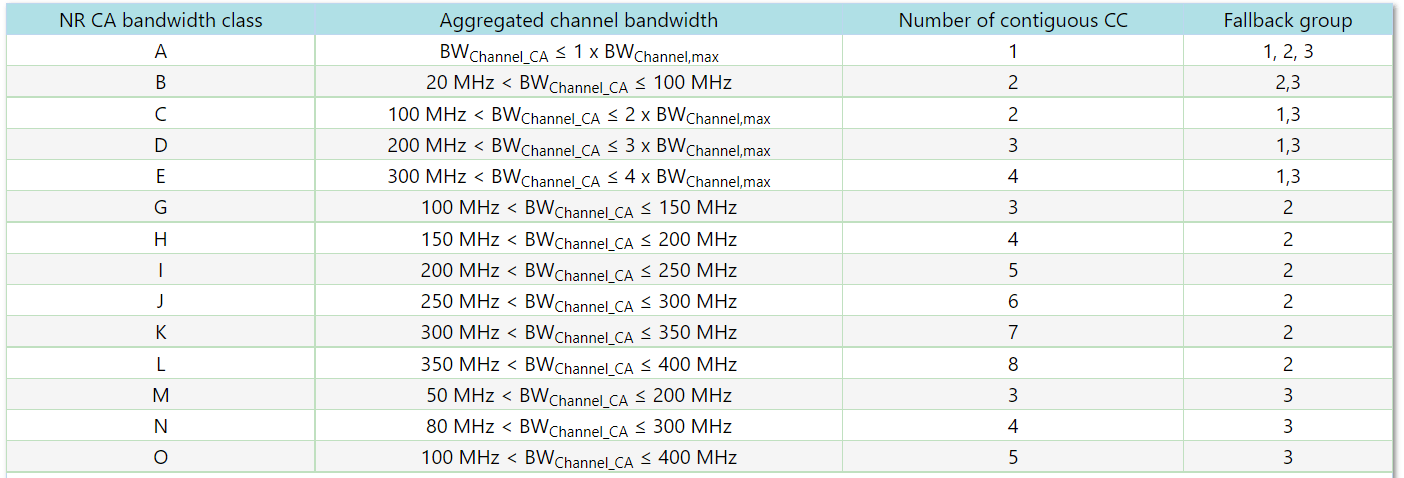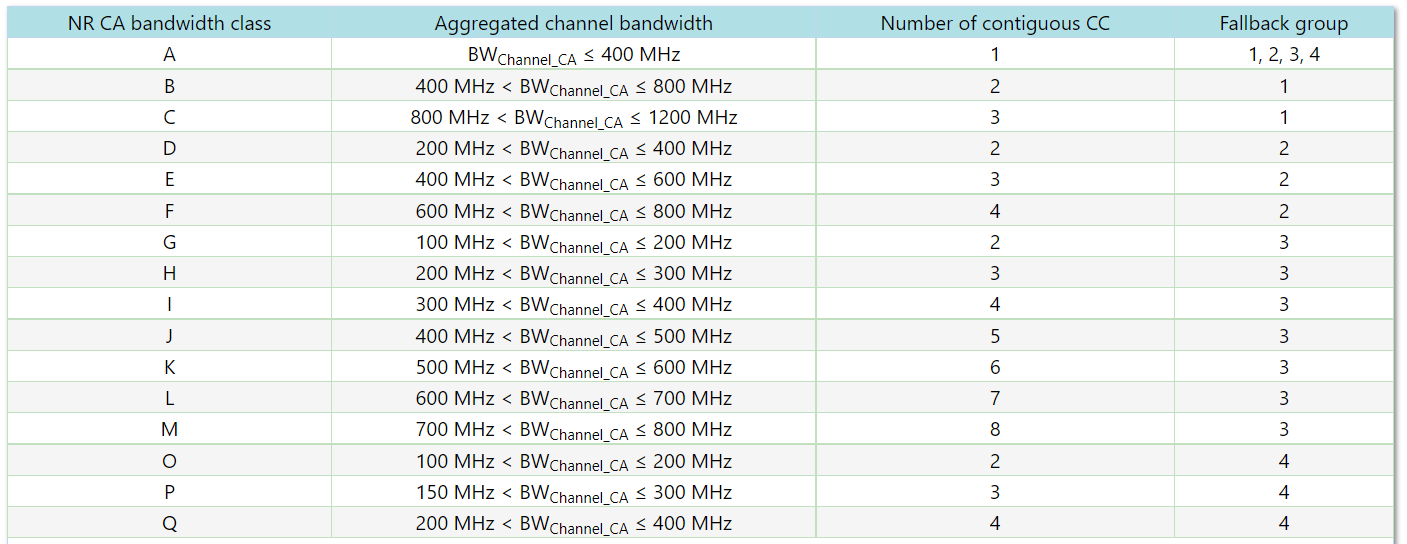5G Carrier Aggregation – Bandwidth Classes
Carrier Aggregation Bandwidth Classes
Carrier Aggregation (CA) increases the bandwidth by combining several carriers. Each aggregated carrier is referred to as a Component Carrier (CC). 5G NR CA supports up to 16 contiguous and non-contiguous CCs with different numerologies in the FR1 band and in the FR2 band. A Carrier aggregation configuration includes the type of carrier aggregation (intra-band, contiguous or not or inter-band), no. of bands and the bandwidth class.
CA Bandwidth Class is a Series of Alphabets, which defines the minimum and maximum bandwidth along with the no. of Components Carriers.
Bandwidth Class Key Pointer
- 5G NR CA supports up to 16 contiguous and non-contiguous CCs with different numerologies
- Bandwidth Class is a Series of Alphabets, which defines the min. and max. bandwidth along with the no. of CCs
- FR1 has CA Class starting from A to O as per release 17
- FR1 bands allows total max. CA bandwidth as 400 MHz
- FR2 has CA Class starting from A to Q per release 17
- FR2 bands allows total max. CA bandwidth as 800 MHz
CA – Bandwidth Classes for FR1

- Class A corresponds to a 5G-NR configuration without carrier aggregation. The maximum 5G carrier band (BWChannel, max) depends on the band number and the numerology. Numerology defines the frequency spacing SCS between sub-carrier (Sub Carrier Spacing). Class A belongs to all the fallback groups and allows the mobile to return to a basic configuration without aggregation of carriers.
- Class B corresponds to a total bandwidth between 20 MHz and 100 MHz by the aggregation of two radio channels
- Class C corresponds to a total bandwidth between 100 MHz and 200 MHz from the aggregation of two radio channels
- Class D corresponds to a total bandwidth between 200 MHz and 300 MHz from the aggregation of three radio channels
- Class E corresponds to a total bandwidth between 300 MHz and 400 MHz from the aggregation of four radio channels. Classes C, D and E belong to the same Fallback Group 1 fallback group.
- Class G corresponds to a total bandwidth between 100 MHz and 150 MHz from the aggregation of three radio channels
- Class H corresponds to a total bandwidth between 150 MHz and 200 MHz from the aggregation of four radio channels
- Class I corresponds to a total bandwidth between 200 MHz and 250 MHz from the aggregation of five radio channels
- Class J corresponds to a total bandwidth between 250 MHz and 300 MHz from the aggregation of six radio channels
- Class K corresponds to a total bandwidth between 300 MHz and 350 MHz from the aggregation of seven radio channels
Class L corresponds to a total bandwidth between 350 MHz and 400 MHz from the aggregation of eight radio channels. Classes G to L belong to the same Fallback Group 2 fallback group
CA – Bandwidth Classes for FR2

- Class A corresponds to a 5G-NR configuration without carrier aggregation. The maximum 5G carrier band (BWChannel, max) depends on the band number and numerology. Class A belongs to all the fallback groups, thus allowing the mobile to return to a basic configuration without aggregation of carriers.
- Class B corresponds to a total bandwidth between 400 MHz and 800 MHz from the aggregation of two radio channels
- Class C corresponds to a total bandwidth between 800 MHz and 1200 MHz from the aggregation of two radio channels.Class B is a fallback configuration for class C, both of which belong to the same FallBack group 1 fallback list.
- Class D corresponds to a total bandwidth between 200 MHz and 400 MHz from the aggregation of two radio channels
- Class E corresponds to a total bandwidth between 400 MHz and 600 MHz from the aggregation of three radio channels
- Class F corresponds to a total bandwidth between 600 MHz and 800 MHz from the aggregation of four radio channels. Classes D, E and F belong to the same FallBack group 2 fallback list.
- Class G corresponds to a total bandwidth between 100 MHz and 200 MHz from the aggregation of two radio channels
- Class H corresponds to a total bandwidth between 200 MHz and 300 MHz from the aggregation of three radio channels
- Class I corresponds to a total bandwidth between 300 MHz and 400 MHz from the aggregation of four radio channels
- Class J corresponds to a total bandwidth between 400 MHz and 500 MHz from the aggregation of five radio channels
- Class K corresponds to a total bandwidth between 500 MHz and 600 MHz from the aggregation of six radio channels
- Class L corresponds to a total bandwidth between 600 MHz and 700 MHz from the aggregation of seven radio channels
- Class M corresponds to a total bandwidth between 700 MHz and 800 MHz from the aggregation of eight radio channels. Classes G, H, I, J, K, L and M belong to the same FallBack group 3 fallback list.
Reference
- 3GPP TS 38.101: 5G NR User Equipment (UE) radio transmission and reception;
Related Post
- 5G NR Multiplex Access Techniques
- 5G NR Physical Layer Vulnerability- Jamming, Sniffing and Spoofing
- 5G NR Bandwidth Part(BWP)
